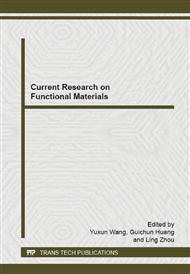[1]
Manoj K Y, Manoranjan G, Ranjit B, et al. Band-gap Variation in Mg- and Cd-doped ZnO Nanostructures and Molecular Clusters [J]. Phys. Rev. B. 2007, 76, 195450.
Google Scholar
[2]
Litty I, Nampoori V P N., Radhakrishnan P, et al. Size-dependent Enhancement of Nonlinear Optical Properties in Nanocolloids of ZnO[J]. J. Appl. Phys. 2008, 103, 033105.
DOI: 10.1063/1.2838178
Google Scholar
[3]
Schulze K, Maennig B, Leo K, et al. Organic Solar Cells on Indium Tin Oxide and Aluminum Doped Zinc Oxide Anodes[J]. Appl. Phys. Lett. 2007, 91, 073521.
DOI: 10.1063/1.2771050
Google Scholar
[4]
Scheer R., Walter T., Schock H.W., Fearheiley M. L., and Lewerenz H. J., CuInS2 based thin film solar cell with 10. 2% efficiency[J], Appl. Phys. Lett., 1993, 63(24): 3294.
DOI: 10.1063/1.110786
Google Scholar
[5]
LU Wen-zhong, JIA Xiao-long, HE Xiao-ming. Influences of Technical Conditions on the Structure of ZnO Films Deposited by DC Magnetic Control Sputtering [J]. Journal of Synthetic Crystals, 2004, 33, 1: 35~39.
Google Scholar
[6]
Wei X H, Li Y R, Zhu J, et al. Epitaxial Properties of ZnO Thin Films on SrTiO3 Substrate Grown by Laser Molecular Beam Epitaxial[J]. Appl. phys. lett, 2007, 90: 151518-1-3.
DOI: 10.1063/1.2719026
Google Scholar
[7]
Liu C, Chang S H, Noh T W, et al. Initial Growth Behavior and Resulting Microstructural Properties of Heteroepitaxial ZnO Thin Films on Sapphire (0001) Substrates[J]. Appl. phys. lett, 2007, 90: 011906-1-3.
DOI: 10.1063/1.2428489
Google Scholar
[8]
N. A. Suvorova, I. O. Usov and L. Stan et al, Structural and optical properties of ZnO thin films by rf magnetron sputtering with rapid thermal annealing, [J]. Appl. Phys. Lett., 2008, 92, 141911: 1-3.
DOI: 10.1063/1.2896642
Google Scholar
[9]
Kim N.H. and Kim H.W., Room temperature growth of high quality ZnO thin film on sapphire substrates, J. Mater. Sci., 2004, 39 (9): 3235-3236.
DOI: 10.1023/b:jmsc.0000025867.97303.74
Google Scholar
[10]
Z.W. Liu C.K. Ong, Synthesis and size control of ZnO nanorods by conventional pulsed-laser deposition without catalyst [J]. Mater Lett. 2007, 61(16): 3329-3333.
DOI: 10.1016/j.matlet.2006.11.066
Google Scholar
[11]
A.M. ALI, T. Inokuma, Y. Kurata, et al. Structural and Optical properties of Nanocrystalline Silicon Films Deposited by Plasma-Enhanced Chemical Vapor Deposition. Jpn[J]. J. Appl. Phys. 2002, 41: 169-175.
DOI: 10.1143/jjap.41.169
Google Scholar
[12]
Srinivasan . G, and Kumar .J., Optical and Structural Characterisation of Zinc Oxide Thin Films Prepared by Sol-gel Process, Cryst. Res. Technol., 2005, 41(9): 893.
DOI: 10.1002/crat.200510690
Google Scholar
[13]
J. P. Lin and J. M. Wu. The effect of annealing processes on electronic properties of sol-gel derived Al-doped ZnO films [J]. Appl. Phys. Lett., 2008, 92(13): 134103-1-3.
DOI: 10.1063/1.2905279
Google Scholar
[14]
Sivaramakrishnan K. and Alford T.L., Metallic conductivity and the role of copper in ZnO/Cu/ZnO thin films for flexible electronics, Appl. Phys. Lett., 2009, 94(5): 052104.
DOI: 10.1063/1.3077184
Google Scholar


